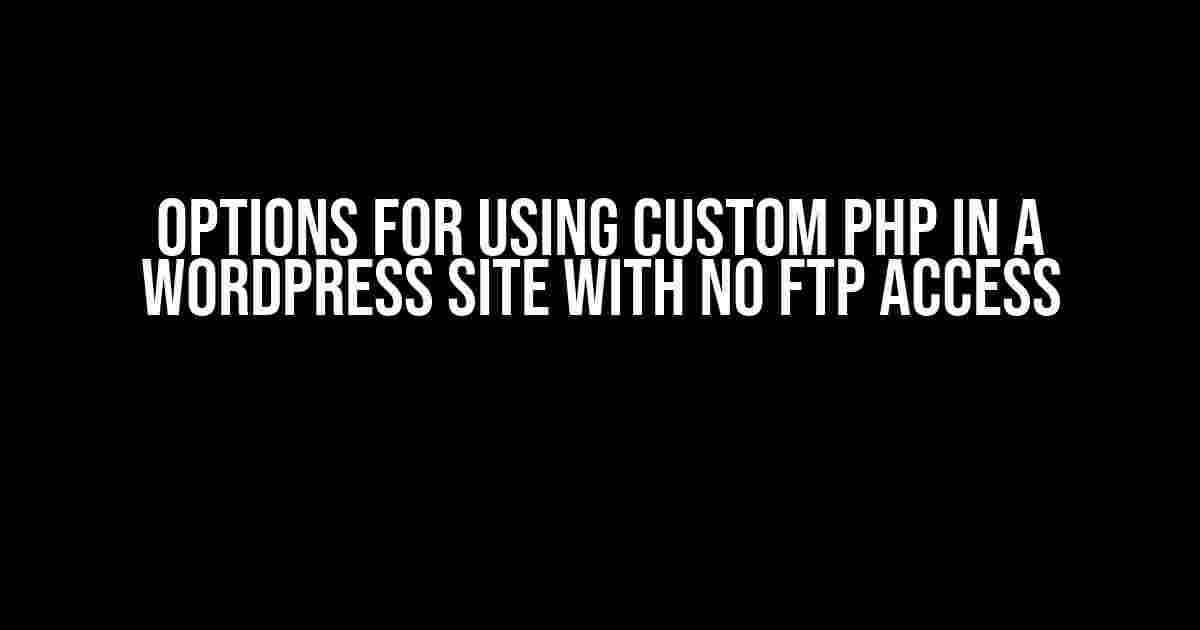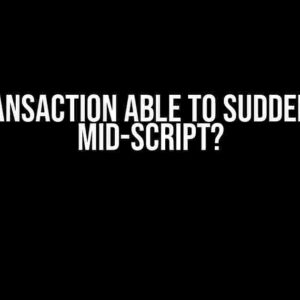So, you want to unlock the full potential of your WordPress site by incorporating custom PHP code, but you’re stuck without FTP access. Don’t worry, we’ve got you covered! In this comprehensive guide, we’ll explore the various options for using custom PHP in a WordPress site, even when you don’t have the luxury of FTP access.
The Obstacles of No FTP Access
FTP (File Transfer Protocol) access allows you to directly edit and upload files to your website’s server. However, in some cases, your hosting provider or website administrator might restrict FTP access for security or management reasons. This limitation can make it challenging to add custom PHP code to your WordPress site. But fear not, there are workarounds!
Option 1: Using the WordPress File Editor
WordPress comes with a built-in file editor that allows you to edit your theme files directly from the dashboard. You can use this editor to add custom PHP code to your functions.php file or other theme files.
- Log in to your WordPress dashboard and navigate to the Appearance > Editor section.
- Select the theme you want to edit and click on the “functions.php” file.
- Click the “Update File” button to begin editing.
- Add your custom PHP code to the file, making sure to follow PHP syntax rules.
- Click the “Update File” button to save your changes.
Keep in mind that the WordPress file editor has some limitations. It may not support syntax highlighting, and you won’t be able to edit files outside of your theme directory.
Option 2: Using a Plugin
Luckily, there are several WordPress plugins that can help you add custom PHP code to your site without FTP access. Here are a few popular options:
Code Snippets: This plugin allows you to add custom PHP code snippets to your site without editing theme files. You can activate, deactivate, and delete snippets as needed.Insert Headers and Footers: This plugin lets you add custom code to your site’s header and footer sections. You can use it to add PHP code, JavaScript, or CSS.WP File Manager: This plugin provides a file manager interface within your WordPress dashboard, allowing you to upload, edit, and delete files without FTP access.
To use a plugin, simply install and activate it from the WordPress plugin directory. Then, follow the plugin’s instructions for adding custom PHP code.
Option 3: Using a Theme with Built-in PHP Editor
Some WordPress themes come with a built-in PHP editor or custom code section. If you’re using a theme that offers this feature, you can take advantage of it to add custom PHP code.
For example, some popular themes like Astra, GeneratePress, and Hello Elementor offer a custom code section or PHP editor within their theme settings.
To use a theme’s built-in PHP editor, navigate to the theme settings or customizer and look for the relevant section. Then, add your custom PHP code and save your changes.
Option 4: Using a Page Builder with Custom PHP Support
Some page builders, like Elementor and Beaver Builder, offer custom PHP support. You can use their built-in PHP editors or modules to add custom PHP code to your pages or widgets.
For example, Elementor has a “Custom PHP” module that allows you to add PHP code to your pages or sections. Similarly, Beaver Builder has a “PHP” module that lets you add custom PHP code to your layouts.
To use a page builder’s custom PHP feature, create a new page or layout, and then add the relevant module or section. Enter your custom PHP code and save your changes.
Option 5: Using a Third-Party Code Editor
If you’re comfortable with coding and want a more comprehensive solution, you can use a third-party code editor like Visual Studio Code or Sublime Text. These editors allow you to connect to your website’s FTP or SFTP server and edit files directly.
To use a third-party code editor, you’ll need to:
- Install the code editor on your local machine.
- Set up an FTP or SFTP connection to your website’s server using the editor’s built-in FTP client or a third-party plugin.
- Navigate to the theme files or plugin directory and edit the relevant PHP files using the editor.
- Save your changes, and the editor will upload the updated files to your server.
Keep in mind that this option requires some technical expertise and a good understanding of FTP and SFTP protocols.
Best Practices and Security Considerations
When adding custom PHP code to your WordPress site, it’s essential to follow best practices and security guidelines to avoid potential vulnerabilities:
- Always test your custom PHP code on a staging site before deploying it to your live site.
- Use a code editor or IDE with syntax highlighting and error checking to catch any mistakes.
- Keep your custom PHP code organized and well-documented for easier maintenance.
- Avoid using untested or unknown PHP code, as it may contain malicious scripts.
- Use secure coding practices, such as validating user input and using prepared statements to prevent SQL injection attacks.
Conclusion
In conclusion, adding custom PHP code to a WordPress site without FTP access is not impossible. With the options outlined above, you can still unlock the full potential of your site and add custom functionality without relying on FTP access.
Remember to always follow best practices and security guidelines when working with custom PHP code to ensure the integrity and security of your website.
| Option | Description | Recommended for |
|---|---|---|
| WordPress File Editor | Edit theme files directly from the WordPress dashboard | Small code snippets, theme modifications |
| Plugin | Use a plugin to add custom PHP code to your site | Code snippets, header and footer modifications, file management |
| Theme with Built-in PHP Editor | Use a theme with a built-in PHP editor or custom code section | Theme modifications, custom functionality |
| Page Builder with Custom PHP Support | Use a page builder with custom PHP support | Page-level customizations, layouts, and widgets |
| Third-Party Code Editor | Use a third-party code editor to connect to your website’s server | Advanced users, large-scale modifications, theme development |
I hope this guide has helped you find a suitable solution for adding custom PHP code to your WordPress site without FTP access. Happy coding!
Frequently Asked Question
Are you stuck with a WordPress site and no FTP access, but still want to use custom PHP? Don’t worry, we’ve got you covered!
What are the options for using custom PHP in a WordPress site without FTP access?
Don’t worry, there are several options! You can use plugins like Code Snippets, Insert PHP, or PHP Everywhere, which allow you to add custom PHP code without needing FTP access. You can also use the WordPress Code Editor or the File Manager plugin to edit your site’s files directly from the WordPress dashboard.
What is Code Snippets, and how can it help me?
Code Snippets is a popular WordPress plugin that allows you to add custom PHP code to your site without modifying your theme’s functions.php file. It provides a user-friendly interface to add, edit, and manage your custom code, making it easy to implement custom PHP functionality without requiring FTP access.
How do I use the WordPress Code Editor to add custom PHP code?
The WordPress Code Editor is a built-in feature that allows you to edit your site’s theme and plugin files directly from the WordPress dashboard. To use it, go to Appearance > Editor, select the file you want to edit (e.g., functions.php), and add your custom PHP code. Be cautious when using this method, as incorrect code can break your site.
Are there any security risks associated with using custom PHP code in WordPress?
Yes, using custom PHP code can pose security risks if not done properly. Malicious code can be injected, or your site can become vulnerable to attacks. It’s essential to use trusted plugins, keep your code up-to-date, and regularly monitor your site’s security. Additionally, use a reputable security plugin to help protect your site.
What are some best practices for using custom PHP code in WordPress?
To ensure trouble-free custom PHP code implementation, follow best practices like using a child theme, keeping your code organized, and testing it thoroughly before deploying it to your live site. Also, avoid modifying core WordPress files, and use version control to track changes. Finally, keep your custom code up-to-date with the latest WordPress versions and security patches.




